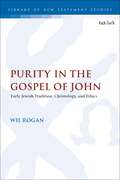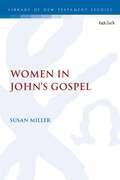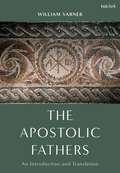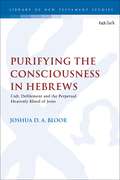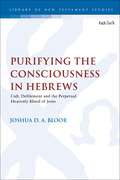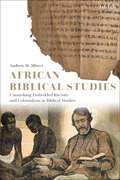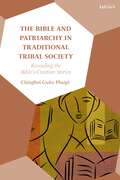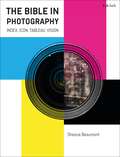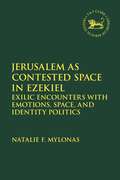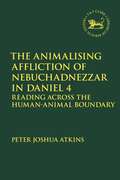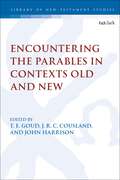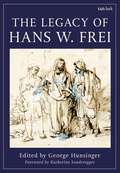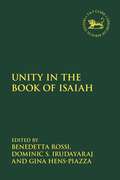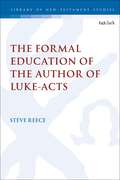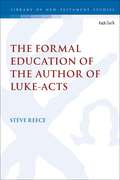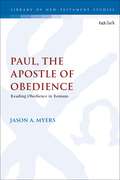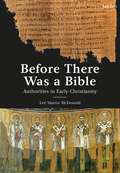- Table View
- List View
Purity in the Gospel of John: Early Jewish Tradition, Christology, and Ethics (The Library of New Testament Studies)
by Wil RoganWil Rogan argues that, contrary to twentieth-century interpretation, the Fourth Gospel did not replace purity with faith in Jesus. Instead, as with other early Jewish writings, its discourse about purity functions as a way to make sense of life before God in the world. He suggests that John's Gospel employs biblical and early Jewish traditions of purity associated with divine revelation and Israel's restoration to narrate how God's people are prepared for the coming of Jesus and enabled by him to have life with God characterized by love. After evaluating different theories of purity for the interpretation of the Fourth Gospel, Rogan explores John the Baptist as an agent of ritual purification, Jesus as the agent of moral purification, and the disciples of Jesus as ones who are (or are not) made morally pure by Jesus. While purity is not one of the Fourth Gospel's primary focuses, Rogan stresses that the concept figures into some of its most significant claims about Christology, the doctrine of salvation, and ethics. Through purity, the Fourth Gospel guards continuity with the past while placing surprising conditions on participation in Israel's future.
Women in John’s Gospel (The Library of New Testament Studies)
by Susan MillerClosely examines John's portrayal of women in relation to discipleship and the theme of new creation, arguing that these depictions are influenced by his apocalyptic world-view. By employing historical and literary methods of biblical interpretation to analyse John's presentation of women and gender, Miller explores the extent to which John gives any indications of the female role in both John's community and the beginnings of the Christian faith.Beginning with the Virgin Mary's portrayal at the wedding at Cana, where she prompts Jesus to carry out his first sign, Miller then thoroughly asses several crucial female characters in John to stress how Jesus' female followers truly recognise him as the Messiah. These include the Samaritan woman, Martha and Mary of Bethany and Mary Magdalene and her encounter with Jesus in the garden. Crucially, Miller suggests that John's frequent use of “woman” links these female followers (particular Jesus' venerated mother) with the figure of Eve in Genesis, and she concludes that women are associated with the “hour” of Jesus when he casts out the “ruler of the world” and inaugurates the new creation.
Women in John’s Gospel (The Library of New Testament Studies)
by Susan MillerClosely examines John's portrayal of women in relation to discipleship and the theme of new creation, arguing that these depictions are influenced by his apocalyptic world-view. By employing historical and literary methods of biblical interpretation to analyse John's presentation of women and gender, Miller explores the extent to which John gives any indications of the female role in both John's community and the beginnings of the Christian faith.Beginning with the Virgin Mary's portrayal at the wedding at Cana, where she prompts Jesus to carry out his first sign, Miller then thoroughly asses several crucial female characters in John to stress how Jesus' female followers truly recognise him as the Messiah. These include the Samaritan woman, Martha and Mary of Bethany and Mary Magdalene and her encounter with Jesus in the garden. Crucially, Miller suggests that John's frequent use of “woman” links these female followers (particular Jesus' venerated mother) with the figure of Eve in Genesis, and she concludes that women are associated with the “hour” of Jesus when he casts out the “ruler of the world” and inaugurates the new creation.
The Apostolic Fathers: An Introduction and Translation
by William VarnerWilliam Varner provides a completely up-to-date introduction to the writings of the Apostolic Fathers. These 1st-2nd Century texts are foundational for the early Christian movement, and the interpretation of the New Testament in the earliest days of what was to later become known as Christianity. Beyond introducing the individual writers Varner also presents and situates their writings, with each chapter offering an introduction followed by key texts. Varner translates these works afresh, and situates them in their original contexts. The introductory materials help readers to interpret these various writings and outline the most important scholarly debates around them, whilst also giving readers access to the texts themselves. The book concludes with a chapter that shows how the Apostolic Fathers are relevant in the 21st century, drawing together threads of reception history and modern Christian theology.
The Apostolic Fathers: An Introduction and Translation
by William VarnerWilliam Varner provides a completely up-to-date introduction to the writings of the Apostolic Fathers. These 1st-2nd Century texts are foundational for the early Christian movement, and the interpretation of the New Testament in the earliest days of what was to later become known as Christianity. Beyond introducing the individual writers Varner also presents and situates their writings, with each chapter offering an introduction followed by key texts. Varner translates these works afresh, and situates them in their original contexts. The introductory materials help readers to interpret these various writings and outline the most important scholarly debates around them, whilst also giving readers access to the texts themselves. The book concludes with a chapter that shows how the Apostolic Fathers are relevant in the 21st century, drawing together threads of reception history and modern Christian theology.
Purifying the Consciousness in Hebrews: Cult, Defilement and the Perpetual Heavenly Blood of Jesus (The Library of New Testament Studies)
by Joshua D. BloorJoshua D. A. Bloor argues that the purification of the consciousness of sin, via Jesus' perpetual heavenly blood offering, is a vital motif for understanding Hebrews' sacrificial argumentation, and vice-versa. Jesus' 'objective' earthly achievements are many, yet only his 'subjective' heavenly blood offering purges the heavenly tabernacle and subsequently the consciousness of sin. Bloor views the Levitical cult as having a positive role in Hebrews, with Levitical 'guilt' foreshadowing and informing Hebrews' notion of the 'consciousness of sin'. Levitical sacrifices could purge the consciousness, but only Jesus' heavenly blood can offer complete perpetual purgation. This blood is a qualitative type of purgation which continually speaks in heaven, offering eternal assurance for the recipients regarding their consciousness of sin. Bloor begins with the 'defiled consciousness' and situates the world of Hebrews within cultic defilement, enabling the consciousness of sin and its cosmic implications to be properly understood. From here, the solution to a defiled consciousness is explored by examining Hebrews' cultic argumentation. Bloor highlights the distinctive purposes inherent in both Jesus' earthly and heavenly achievements, with the latter concerned particularly with Yom Kippur imagery and the purgation of the consciousness. Bloor concludes by differentiating between Jesus' session, present heavenly activity and perpetual heavenly blood offering. Throughout this volume, Bloor engages, critiques and advances current discourse concerning the nature and timing of Jesus' offering in Hebrews.
Purifying the Consciousness in Hebrews: Cult, Defilement and the Perpetual Heavenly Blood of Jesus (The Library of New Testament Studies)
by Joshua D. BloorJoshua D. A. Bloor argues that the purification of the consciousness of sin, via Jesus' perpetual heavenly blood offering, is a vital motif for understanding Hebrews' sacrificial argumentation, and vice-versa. Jesus' 'objective' earthly achievements are many, yet only his 'subjective' heavenly blood offering purges the heavenly tabernacle and subsequently the consciousness of sin. Bloor views the Levitical cult as having a positive role in Hebrews, with Levitical 'guilt' foreshadowing and informing Hebrews' notion of the 'consciousness of sin'. Levitical sacrifices could purge the consciousness, but only Jesus' heavenly blood can offer complete perpetual purgation. This blood is a qualitative type of purgation which continually speaks in heaven, offering eternal assurance for the recipients regarding their consciousness of sin. Bloor begins with the 'defiled consciousness' and situates the world of Hebrews within cultic defilement, enabling the consciousness of sin and its cosmic implications to be properly understood. From here, the solution to a defiled consciousness is explored by examining Hebrews' cultic argumentation. Bloor highlights the distinctive purposes inherent in both Jesus' earthly and heavenly achievements, with the latter concerned particularly with Yom Kippur imagery and the purgation of the consciousness. Bloor concludes by differentiating between Jesus' session, present heavenly activity and perpetual heavenly blood offering. Throughout this volume, Bloor engages, critiques and advances current discourse concerning the nature and timing of Jesus' offering in Hebrews.
African Biblical Studies: Unmasking Embedded Racism and Colonialism in Biblical Studies
by Andrew M. MbuviAndrew M. Mbuvi makes the case for African biblical studies as a vibrant and important emerging distinct discipline, while also using its postcolonial optic to critique biblical studies for its continued underlying racially and imperialistically motivated tendencies. Mbuvi argues that the emergence of biblical studies as a discipline in the West coincides with, and benefits from, the establishment of the colonial project that included African colonization. At the heart of the colonial project was the Bible, not only as ferried by missionaries, who often espoused racialized views, to convert “heathens in the distant lands,” but as the text used in the racialized justification of the colonial violence. Interpretive approaches established within these racist and colonialist matrices continue to dominate the discipline, perpetuating racialized interpretive methodology and frameworks.On these grounds, Mbuvi makes the case that the continued marginalization of non-western approaches is a reflection of the continuing colonialist structure and presuppositions in the discipline of biblical studies. African Biblical Studies not only exposes and critiques these persistent oppressive and subjugating tendencies but showcases how African postcolonial methodologies and studies, that prioritize readings from the perspective of the marginalized and oppressed, offer an alternative framework for the discipline. These readings, while destabilizing and undermining the predominantly white Euro-American approaches and their ingrained prejudices, and problematizing the biblical text itself, posit the need for biblical interpretation that is anti-colonial and anti-racist.
African Biblical Studies: Unmasking Embedded Racism and Colonialism in Biblical Studies
by Andrew M. MbuviAndrew M. Mbuvi makes the case for African biblical studies as a vibrant and important emerging distinct discipline, while also using its postcolonial optic to critique biblical studies for its continued underlying racially and imperialistically motivated tendencies. Mbuvi argues that the emergence of biblical studies as a discipline in the West coincides with, and benefits from, the establishment of the colonial project that included African colonization. At the heart of the colonial project was the Bible, not only as ferried by missionaries, who often espoused racialized views, to convert “heathens in the distant lands,” but as the text used in the racialized justification of the colonial violence. Interpretive approaches established within these racist and colonialist matrices continue to dominate the discipline, perpetuating racialized interpretive methodology and frameworks.On these grounds, Mbuvi makes the case that the continued marginalization of non-western approaches is a reflection of the continuing colonialist structure and presuppositions in the discipline of biblical studies. African Biblical Studies not only exposes and critiques these persistent oppressive and subjugating tendencies but showcases how African postcolonial methodologies and studies, that prioritize readings from the perspective of the marginalized and oppressed, offer an alternative framework for the discipline. These readings, while destabilizing and undermining the predominantly white Euro-American approaches and their ingrained prejudices, and problematizing the biblical text itself, posit the need for biblical interpretation that is anti-colonial and anti-racist.
The Bible and Patriarchy in Traditional Tribal Society: Re-reading the Bible’s Creation Stories
by Chingboi Guite PhaipiChingboi Guite Phaipi examines how biblical texts reinforced female subjugation in Northeast Indian tribal societies after tribes had accepted Christianity in the early 20th century. Phaipi shows how most tribal groups reinforced women's subordinate status by invoking newly authoritative biblical texts such as the creation stories in Genesis 1, 2 and 3.Phaipi studies the creation stories in Genesis to offer broader readings for Christian tribal communities that are communal, traditional, and struggling to retain their women and girls, particularly those who are educated. This volume recognizes and respects tradition, traditional communities, and the enduring witness of faithful lives in tribal communities at the same time as offering ways forward with respect to unworthy cultural practices and preferences that have been legitimised by the Bible. This book offers a contextually sensitive and scholarly reading of the Bible, with particular attention to the ways patriarchal norms in biblical narratives are perpetuated, rather than considered and reformed.
The Bible and Patriarchy in Traditional Tribal Society: Re-reading the Bible’s Creation Stories
by Chingboi Guite PhaipiChingboi Guite Phaipi examines how biblical texts reinforced female subjugation in Northeast Indian tribal societies after tribes had accepted Christianity in the early 20th century. Phaipi shows how most tribal groups reinforced women's subordinate status by invoking newly authoritative biblical texts such as the creation stories in Genesis 1, 2 and 3.Phaipi studies the creation stories in Genesis to offer broader readings for Christian tribal communities that are communal, traditional, and struggling to retain their women and girls, particularly those who are educated. This volume recognizes and respects tradition, traditional communities, and the enduring witness of faithful lives in tribal communities at the same time as offering ways forward with respect to unworthy cultural practices and preferences that have been legitimised by the Bible. This book offers a contextually sensitive and scholarly reading of the Bible, with particular attention to the ways patriarchal norms in biblical narratives are perpetuated, rather than considered and reformed.
The Bible in Photography: Index, Icon, Tableau, Vision (Scriptural Traces)
by Dr. Sheona BeaumontSheona Beaumont addresses the untold story of biblical subjects in photography. She argues that stories, characters, and symbols from the Bible are found to pervade photographic practices and ideas, across the worlds of advertising and reportage, the book and the gallery, in theoretical discourse and in the words of photographers themselves. Beaumont engages interpretative tools from biblical reception studies, art history, and visual culture criticism in order to present four terms for describing photography's latent spirituality: the index, the icon, the tableau, and the vision. Throughout her journey she includes lively discussion of selected fine art photography dealing with the Bible in surprising ways, from images by William Henry Fox Talbot in the 19th century to David Mach in the 21st. Far from telling a secular story, photography and the conditions of its representations are exposed in theological depth.; Beaumont skillfully interweaves discussion of the images and theology, arguing for the dynamic and potent voice of the Bible in photography and enriching visual culture criticism with a renewed religious understanding.
The Bible in Photography: Index, Icon, Tableau, Vision (Scriptural Traces)
by Dr. Sheona BeaumontSheona Beaumont addresses the untold story of biblical subjects in photography. She argues that stories, characters, and symbols from the Bible are found to pervade photographic practices and ideas, across the worlds of advertising and reportage, the book and the gallery, in theoretical discourse and in the words of photographers themselves. Beaumont engages interpretative tools from biblical reception studies, art history, and visual culture criticism in order to present four terms for describing photography's latent spirituality: the index, the icon, the tableau, and the vision. Throughout her journey she includes lively discussion of selected fine art photography dealing with the Bible in surprising ways, from images by William Henry Fox Talbot in the 19th century to David Mach in the 21st. Far from telling a secular story, photography and the conditions of its representations are exposed in theological depth.; Beaumont skillfully interweaves discussion of the images and theology, arguing for the dynamic and potent voice of the Bible in photography and enriching visual culture criticism with a renewed religious understanding.
Jerusalem as Contested Space in Ezekiel: Exilic Encounters with Emotions, Space, and Identity Politics (The Library of Hebrew Bible/Old Testament Studies)
by Natalie MylonasNatalie Mylonas uses Ezekiel 16 as a case study in order to reveal the critical relationship between space, emotion, and identity politics in the Hebrew Bible. Drawing on interdisciplinary research that emphasises how space and emotions are inextricably linked in human experience, Mylonas explores the portrayal of Yhwh's wife, Jerusalem, in Ezekiel 16 as a personified city who feels emotion. She foregrounds purity and gender issues, as well as debates on emotions in the Hebrew Bible, emphasising that spatiality is a key component of how these issues are conceptualised in ancient Israel.This book argues that the power struggle between Jerusalem and Yhwh in Ezekiel 16 is a struggle over the contested space of Jerusalem's body and the city space. Jerusalem's emotions are in a dynamic relationship with the spaces in the text – they are signified by these spaces, shift as the constitution of the spaces shifts, and are shaped by Jerusalem's use of space. Her desire, pride, and shamelessness are communicated spatially through her use of city space, while her representation as disgusting is underscored by her “uncontrollable” female body. Mylonas concludes by showing how Ezekiel's vision of the new Jerusalem in Ezekiel 40-48 re-establishes sacred space through the erasure of the feminine city metaphor coupled with strict boundary policing, which is a far cry from the assault on Jerusalem's boundaries described in Ezekiel 16.
Animalising Affliction of Nebuchadnezzar in Daniel 4: Reading Across the Human-Animal Boundary (The Library of Hebrew Bible/Old Testament Studies)
by Peter Joshua AtkinsThis is a detailed investigation into the nature of Nebuchadnezzar's animalising affliction in Daniel 4 and the degree to which he is depicted as actually becoming an animal. PeterAtkins examines two predominant lines of interpretation: either Nebuchadnezzar undergoes a physical metamorphosis of some kind into an animal form; or diverse other readings that specifically preclude or deny an animal transformation of the king. By providing an extensive study of these interpretative opinions, alongside innovative assessments of ancient Mesopotamian divine-human-animal boundaries, Atkins ultimately demonstrates how neither of these traditional interpretations best reflect the narrative events. While there have been numerous metamorphic interpretations of Daniel 4, these are largely reliant upon later developments within the textual tradition and are not present in the earliest edition of Nebuchadnezzar's animalising affliction. Atkins' study displays that when Daniel 4 is read in the context of Mesopotamian texts, which appear to conceive of the human-animal boundary as being indicated primarily in relation to possession or lack of the divine characteristic of wisdom, the affliction represents a far more significant categorical change from human to animal than has hitherto been identified.
Encountering the Parables in Contexts Old and New (The Library of New Testament Studies)
by T. E. Goud, J. R. C. Cousland, John Harrison, and contributorsThe contributors to this book pursue three important lines of inquiry into parable study, in order to illustrate how these lessons have been received throughout the millennia. The contributors consider not only the historical and material world of the parables' composition, and focusing on the social, political, economic, and material reality of that world, but also seek to connect how the parables may have been seen and heard in ancient contexts with how they have been, and continue to be, seen and heard.Intentionally allowing for a “bounded openness” of approach and interpretation, these essays explore numerous contexts, encounters and responses. Examining topics ranging from ancient harvest imagery and dependency relations to contemporary experience with the narratives and lessons of the parables, this volume seeks to link those very real ancient contexts with our own varied modern contexts.
Encountering the Parables in Contexts Old and New (The Library of New Testament Studies)
The contributors to this book pursue three important lines of inquiry into parable study, in order to illustrate how these lessons have been received throughout the millennia. The contributors consider not only the historical and material world of the parables' composition, and focusing on the social, political, economic, and material reality of that world, but also seek to connect how the parables may have been seen and heard in ancient contexts with how they have been, and continue to be, seen and heard.Intentionally allowing for a “bounded openness” of approach and interpretation, these essays explore numerous contexts, encounters and responses. Examining topics ranging from ancient harvest imagery and dependency relations to contemporary experience with the narratives and lessons of the parables, this volume seeks to link those very real ancient contexts with our own varied modern contexts.
The Legacy of Hans W. Frei
by George HunsingerThis volume demonstrates Hans W. Frei's unique contribution to theology and biblical hermeneutics. Divided into five parts, the volume first outlines key biographical details, including a littleknown interview from 1980 (excerpted), and Frei's Jewish background while growing up in Nazi Germany. The subsequent four parts offer insights into both the centrality of biblical narrative and its fateful eclipse by modernity, as well as Frei's usage of Anselm and Barth. The scholars who contribute to this volume examine Frei's analytical rigor, his plea for a “high Christology” in the service of the church; and his shifting interpretations over the years regarding scripture's “literal sense”. They examine Frei's relationship to other contemporary notables such as Paul Ricoeur, Eberhard Jüngel, George A. Lindbeck and Carl F. H. Henry, along with an alternative Roman Catholic reading of the history of biblical hermeneutics over against the one he advocates.
The Legacy of Hans W. Frei
by George HunsingerThis volume demonstrates Hans W. Frei's unique contribution to theology and biblical hermeneutics. Divided into five parts, the volume first outlines key biographical details, including a littleknown interview from 1980 (excerpted), and Frei's Jewish background while growing up in Nazi Germany. The subsequent four parts offer insights into both the centrality of biblical narrative and its fateful eclipse by modernity, as well as Frei's usage of Anselm and Barth. The scholars who contribute to this volume examine Frei's analytical rigor, his plea for a “high Christology” in the service of the church; and his shifting interpretations over the years regarding scripture's “literal sense”. They examine Frei's relationship to other contemporary notables such as Paul Ricoeur, Eberhard Jüngel, George A. Lindbeck and Carl F. H. Henry, along with an alternative Roman Catholic reading of the history of biblical hermeneutics over against the one he advocates.
Unity in the Book of Isaiah (The Library of Hebrew Bible/Old Testament Studies)
Building on previous holistic readings of the Book of Isaiah, this collection approaches Isaiah through the concept of unity. Contributors outline research that point to new directions in the unity movement and, in the process, bring it under a critical gaze, considering the perennial challenges to unity reading and thus problematizing the very concept of unity.Divided into four parts, the book provides methodological reflections on reading Isaiah as a unity, and examines historical and redactional readings, literary readings and contextual or reader-orientated readings. Topics include how the figure of Jacob functions as a unifying motif in the final form of the book, Isaiah 1 as an example of the relevance of local structure for global coherence and how woman as a root metaphor of Zion not only bears revelatory significance but also serves as a theological linchpin for a more holistic reading of the book. Overall, the book highlights the continued promise of holistic readings for diverse methods and varied approaches to the Book of Isaiah.
The Formal Education of the Author of Luke-Acts (The Library of New Testament Studies)
by Steve ReeceSteve Reece proposes that the author of Luke-Acts was trained as a youth in the primary and secondary Greek educational curriculum typical of the Eastern Mediterranean during the Roman Imperial period, where he gained familiarity with the Classical and Hellenistic authors whose works were the focus of study. He makes a case for Luke's knowledge of these authors internally by spotlighting the density of allusions to them in the narrative of Luke-Acts, and externally by illustrating from contemporary literary, papyrological, and artistic evidence that the works of these authors were indeed widely known in the Eastern Mediterranean at the time of the composition of Luke-Acts, not only in the schools but also among the general public.Reece begins with a thorough examination of the Greek educational system during the Hellenistic and Roman Imperial periods, emphasizing that the educational curriculum was very homogeneous, at least at the primary and secondary levels, and that children growing up anywhere in the Eastern Mediterranean could expect to receive quite similar educations. His close examination of the Greek text of Luke-Acts has turned up echoes, allusions, and quotations of several of the very authors that were most prominently featured in the school curriculum: Homer, Aesop, Euripides, Plato, and Aratus. This reinforces the view that Luke, along with other writers of the New Testament, lived in a cultural milieu that was influenced by Classical and Hellenistic Greek literature and that he was not averse to invoking that literature when it served his theological and literary purposes.
The Formal Education of the Author of Luke-Acts (The Library of New Testament Studies)
by Steve ReeceSteve Reece proposes that the author of Luke-Acts was trained as a youth in the primary and secondary Greek educational curriculum typical of the Eastern Mediterranean during the Roman Imperial period, where he gained familiarity with the Classical and Hellenistic authors whose works were the focus of study. He makes a case for Luke's knowledge of these authors internally by spotlighting the density of allusions to them in the narrative of Luke-Acts, and externally by illustrating from contemporary literary, papyrological, and artistic evidence that the works of these authors were indeed widely known in the Eastern Mediterranean at the time of the composition of Luke-Acts, not only in the schools but also among the general public.Reece begins with a thorough examination of the Greek educational system during the Hellenistic and Roman Imperial periods, emphasizing that the educational curriculum was very homogeneous, at least at the primary and secondary levels, and that children growing up anywhere in the Eastern Mediterranean could expect to receive quite similar educations. His close examination of the Greek text of Luke-Acts has turned up echoes, allusions, and quotations of several of the very authors that were most prominently featured in the school curriculum: Homer, Aesop, Euripides, Plato, and Aratus. This reinforces the view that Luke, along with other writers of the New Testament, lived in a cultural milieu that was influenced by Classical and Hellenistic Greek literature and that he was not averse to invoking that literature when it served his theological and literary purposes.
Paul, The Apostle of Obedience: Reading Obedience in Romans (The Library of New Testament Studies)
by Jason A. MyersJason A. Myers reconsiders the meaning and context of the phrase “the obedience of faith” in Rom 1:5 and how it contributes to the theme of obedience in Romans. In contrast to previous studies that have nearly exclusively focused on the obedience language in light of the Hebrew Bible and Second Temple literature, Myers instead investigates how this language functioned within the Greco-Roman world, particularly in the discourse of the Roman Empire.By studying both the Greco-Roman contexts and the use of obedience language during the Empire, Myers sheds fresh light on the meaning of “the obedience of faith,” and concludes that such examination helps contemporary readers understand how Gentiles in Paul's audience would have heard and received the terms and images relating to obedience. In addition, he argues that Paul's use of obedience language, both at the beginning and end of Romans (1:5; 15:18), serves as rhetorical bookends, and signals a theme that is central to Paul's purpose in Romans and integral to his calling as an apostle to the Gentiles.
Paul, The Apostle of Obedience: Reading Obedience in Romans (The Library of New Testament Studies)
by Jason A. MyersJason A. Myers reconsiders the meaning and context of the phrase “the obedience of faith” in Rom 1:5 and how it contributes to the theme of obedience in Romans. In contrast to previous studies that have nearly exclusively focused on the obedience language in light of the Hebrew Bible and Second Temple literature, Myers instead investigates how this language functioned within the Greco-Roman world, particularly in the discourse of the Roman Empire.By studying both the Greco-Roman contexts and the use of obedience language during the Empire, Myers sheds fresh light on the meaning of “the obedience of faith,” and concludes that such examination helps contemporary readers understand how Gentiles in Paul's audience would have heard and received the terms and images relating to obedience. In addition, he argues that Paul's use of obedience language, both at the beginning and end of Romans (1:5; 15:18), serves as rhetorical bookends, and signals a theme that is central to Paul's purpose in Romans and integral to his calling as an apostle to the Gentiles.
Before There Was a Bible: Authorities in Early Christianity
by Lee Martin McDonaldHow did authority function before the bible as we know it emerged? Lee Martin McDonald examines the authorities that existed from the Church's beginning: the appeal to the texts containing the words of Jesus, and that would become the New Testament, the not yet finalized Hebrew Scriptures (referred to mostly in Greek) and the apostolic leadership of the churches.McDonald traces several sacred core traditions that broadly identified the essence of Christianity before there was a bible summarized in early creeds, hymns and spiritual songs, baptismal and Eucharistic affirmations, and in lectionaries and catalogues from the fourth century and following. McDonald shoes how those traditions were included in the early Christian writings later recognized as the New Testament. He also shows how Christians were never fully agreed on the scope of their Old Testament canon (Hebrew scriptures) and that it took centuries before there was universal acceptance of all of the books now included in the Christian bible. Further, McDonald shows that whilst writings such as the canonical gospels were read as authoritative texts likely from their beginning, they were not yet called or cited as scripture. What was cited in an authoritative manner were the words of Jesus in those texts, alongside the multiple affirmations and creeds that were circulated in the early Church and formed its key authorities and core sacred traditions.
